Knowledge Management and Information Systems Doc
Added on 2020-09-17
25 Pages6009 Words70 Views
KNOWLEDGEMANAGEMENT ANDINFORMATIONSYSTEMS
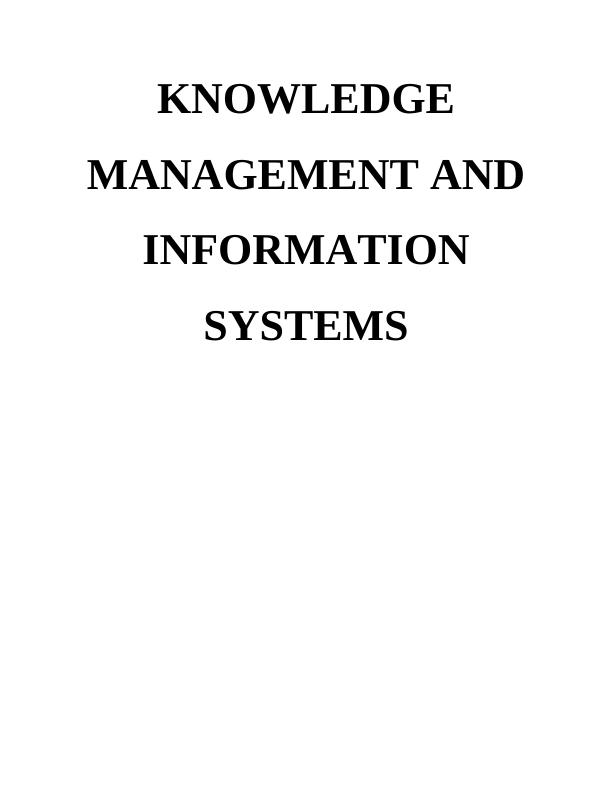
Table of ContentsINTRODUCTION...........................................................................................................................1Part I.................................................................................................................................................12.1.1 Rich picture of stakeholders relevant to the launch of “Revolution”.................................12.1.2 Strategic implications of the two sided network................................................................22.1.3 Recommending IT/IS related system for improving coordination among stakeholders....5Part II...............................................................................................................................................62.2.1 Introduction........................................................................................................................62.2.2 Comparing the two chosen case studies on the basis of formulated dimensions...............82.2.3 Brief conclusion synthesizing upon comparison................................................................9Part III..............................................................................................................................................9Slides and notes for presentation.................................................................................................9CONCLUSION..............................................................................................................................20REFERENCES..............................................................................................................................21
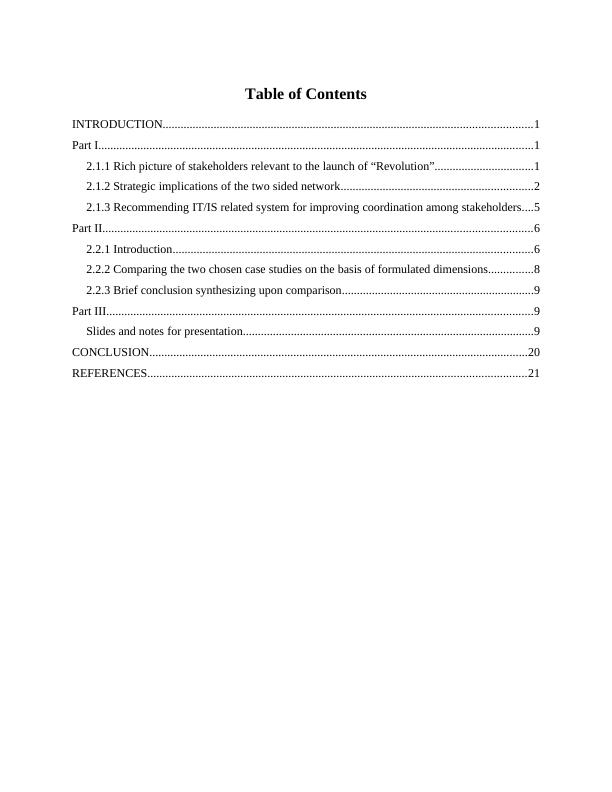
INTRODUCTIONManagement of the knowledge is often inter linked with diversified applications on abusiness such as Information systems of Information Technology. Proper balance of these twoterms ensures formulation of appropriate strategies to effectively deal with customers(Armstrong and Taylor, 2014). The following report is basically divided into 3 parts wherein Part I Is entirely basedupon the Nintendo case study covering the key aspects involved in launching of its Revolution.Part II is entirely based upon the comparison of 2 different case studies which are MercedesBenz and British Airways that usually get treated as leading proprietors in their respectiveindustries. Both these UK firms are effectively realising the need of Customer RelationshipManagement(CRM) to manage their customers issues. In the end Part III will be presenting theNintendo case study elements assessed in Part I. Part I2.1.1 Rich picture of stakeholders relevant to the launch of “Revolution”Mr Satoru Iwata always had a vision to establish something more enhanced than justsimple video games. He wanted to expand the era of video to enhance the experience ofcustomers. In context to this, diversified range of stakeholders played an effective role in orderfor effective launching of Revolution (Kim and et.al., 2011). Henceforth, to assess this, followinganalysis will prove to be quite beneficial :-Clients : This takes in consideration particularly associated consumers or the clients incontext to the Revolution. These people tend to be impacted more by the changes thatoccur within the entire system. Contextualising upon the customers of Nintendo'sRevolution, these have always been the core-gamers who always wish to demand more &more. The Revolution aided the Nintendo's customers basic need. This need stated thatinstead of single-handed controller company should develop such a device that could becontrolled by both the hands thereby ensuring flexibility. This played an important role inlaunching of the Revolution. Actors: These people are generally accountable for implementing necessary changeswithin the system. Henceforth, in context to Nintendo's Revolutiom, Itawa assigned ateam was formulated for thinking about the core concepts as well as build up newinnovative techniques to enhance the gaming experience (Becerra-Fernandez and1
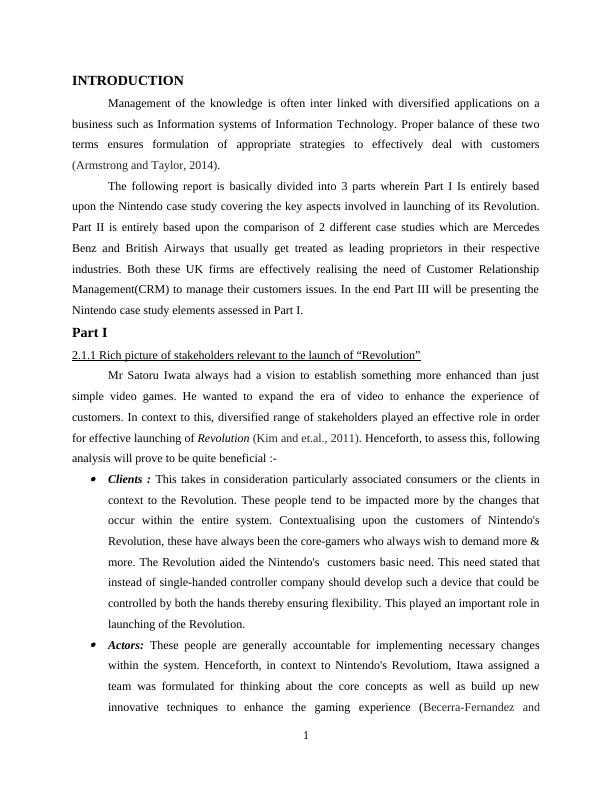
Sabherwal, 2014). This team basically included general managers and other authoritieswithin the division of Integrated Research & Development. These actors played aninfluential role in building up gaming consoles of new generation.Engineers and executives of Nintendo : These people played an important role in thepathway of launching Revolution. They were the ones who put up questions upon theimportance of certain features such as sophisticated control systems. This questioning ledto the development of a brand new project of Revolution thereby departing from theroadmap in technology terms. Technology : Consistent efforts were made in order for effective utilisation of the latesttechnologies. The team of Nintendo was always planning upon making use of newtechnology after one technique was utilised in an efficient manner. They do not believe inscratching out products or technology. Their basic designing procedures entirelyemphasize upon the current trends in the field of technology. Traditionally, everycompany follows a particular roadmap which is a type of overview regarding thetechnology which has to be proposed. However, opposite situation is faced in case ofNintendo where engineers took a turn from such type of roadmaps.Structure of the organisation : The structure of Nintendo also played a key role inlaunching of the Revolution. As observed, the structure is usually a mix of bothfunctional and hierarchy matrix. Each of the task or procedure that is carried in Nintendo,usually has a development-team which works upon it. In every team there is a leader thatis responsible for reporting to the manager about whatever activity currently goes on.And after this, managers of different departments report to each other for discussingabout the diversified stages in the process which is to be implemented. Also, the heads incase of the software & hardware department consistently report their findings oroutcomes to the general-manager of that development-area in particular (Donate and de-Pablo, 2015). And from that point information tends to flow in uphill-manner. 2

2.1.2 Strategic implications of the two sided networkA. Two sided Network and evaluating the Revolutions Business ModelThe companies that come ion the circle of media, banking tend to make more money bygetting linked with diversified markets regarding their networks of customers. These networkscould include advertisers as well as audience. These tend to be a type of economic platformswhich enable the two connected parties or networks to share the benefits obtained. The offeringsof the products within many industries & companies are shared. However, despite the positiveimpacts of the two sided network, there are some challenges that tend to impose a negative3
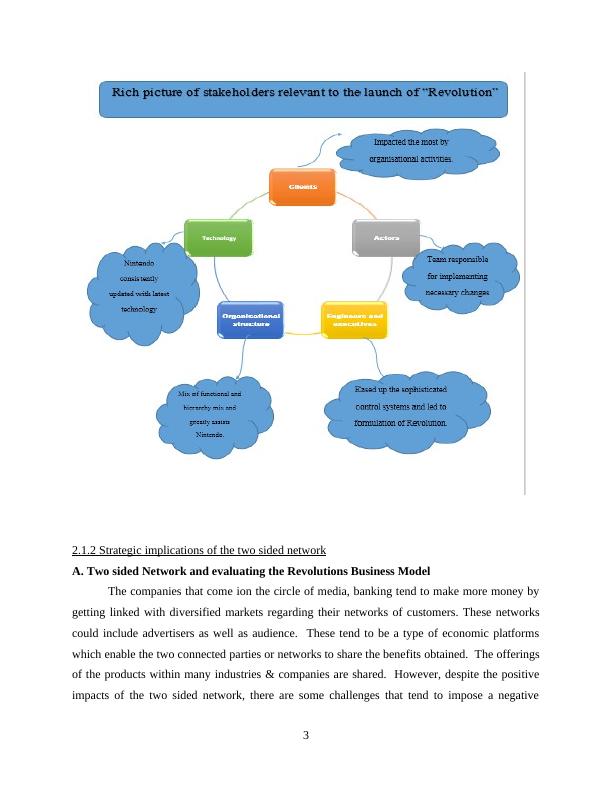
impact upon the such auspicious network. Contextualising the video gaming industry, it is highlybased upon the externalities of the network. For preservation of the consoled hardware gamershad to be convinced for not switching as per the growth in gaming industry. Also, complexityhad been facing gradual increase in this industry. Also, it was not at all agreeable that Microsoftand Sony dominate the gaming market because this was posing a threat by reducing theirbargain-power in the negotiations of sharing profits. However, this proved to be a great boon forNintendo since there were ample third party publishers who were ready to help Nintendo informulating console efforts (Dumais and et.al., 2016). This positively impacted their establishednetwork to launch Revolution. The services as well as products that usually tend to bring the diversified users fromgroups altogether within the two sided networks are known as platforms. So, the first challengeaccounts to be the formulation of pricing in context to the platform within two sided networks.Also, when the scale of network-industry is foreseeing enhanced returns then, this leads towardsthe winner taking away all the battles coming across. So, the provider of the platform often hasto think upon whether sharing the platform with rivalries or to fight for their survival. Thisaccounts to be the third challenge. Platform sharers often provide a leverage in context to theirshared relationships to each other. Henceforth, one of the platform provider often swallows otherprovider's network. This enveloping is usually treated as threat. (i)Unique properties of the involved value chain : →Inbound : With reference to the Nintendo's Revolution, upon the certain components,production process is usually outsourced, thereby differentiating from others. This tends toenable them the facility of in-house for cost minimization. In context to Revolution as well, thecompanies with which they had established contract were preferred for buying process (Galliersand Leidner, 2014). This further lets them to reduce the costs involved and implement thefeatures in their products as per their choice. →Operations in context to in house : The raw materials of Nintendo are gradually convertedinto their finished products at the factories situated in Japan. Although, the division situated inAustralia effectively assembles the goods that are produced. Finally, the team of Sales andMarketing I responsible for pushing out the way in the best possible way. →Logistic of the outbound : It is found from the current scenario that Sony and Microsoft incomparison to Nintendo's Revolution are not having a high level of control upon the outlets of4
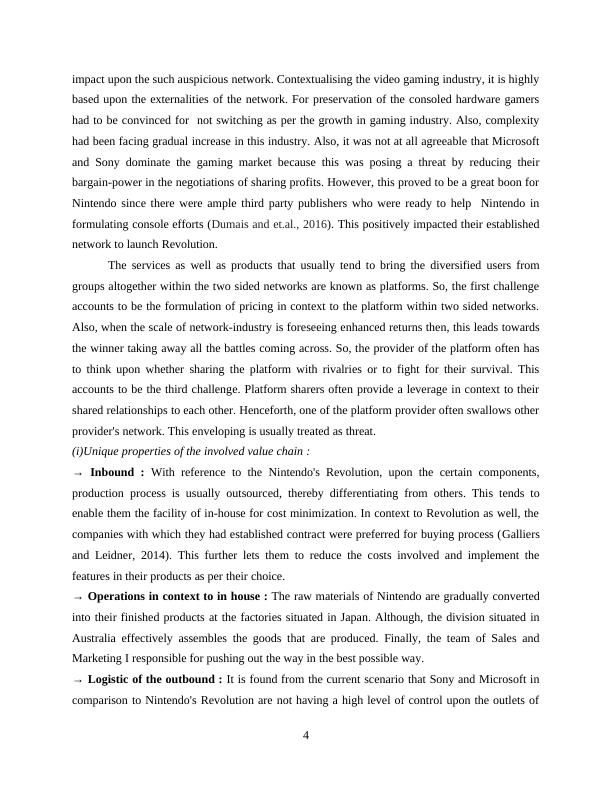
End of preview
Want to access all the pages? Upload your documents or become a member.
Related Documents
Research Report on Nintendolg...
|16
|4475
|688
Knowledge Management Systems and Information Systemslg...
|13
|499
|238
